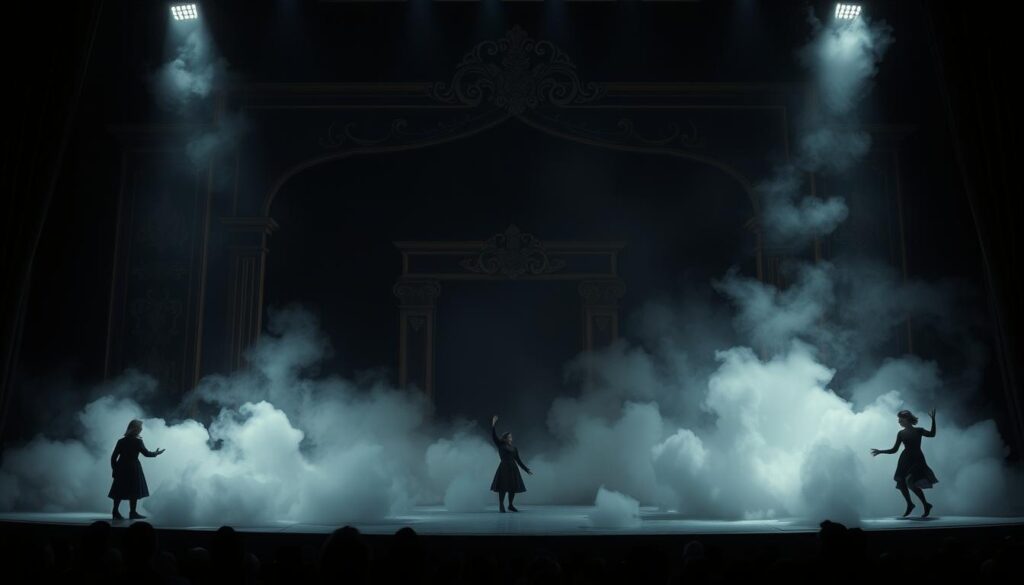Imagine a performer on stage, making everyone gasp with a disappearing act. Their form vanishes, leaving the audience amazed. But disappearing isn’t just for stage tricks. It has fascinated us for centuries, in books and history.
Disappearance has always been captivating, sparking our curiosity. Famous people have vanished, and stories in books have characters disappear. This has shaped how we see the world. By looking into the psychology, culture, and art of disappearing, we gain a new respect for it.
Disappearing acts, whether by magic or in stories, grab our attention. Let’s explore the world of vanishing acts together. We’ll look at the stories, symbols, and impacts that make it a big part of our lives.
Understanding the Psychology of Disappearance in Literature
The art of disappearance has long fascinated readers, authors, and scholars. It appears in modern writing and has cultural significance. Exploring its psychological impact on readers is intriguing.
Metaphorical Representations in Modern Writing
In books like “Vanishing Acts” by Ellen Datlow, disappearance is used to symbolize endangered species and human fragility. Authors use tricks like escapology and misdirection to connect with readers. This creates emotional responses and makes us think deeply about life.
Cultural Significance of Vanishing Narratives
Stories about disappearance have a special cultural meaning. They tap into our fascination with the unknown. These tales reflect our desire to understand human experiences.
Impact on Reader Psychology
Disappearance stories can deeply affect readers. They spark curiosity, fear, and vulnerability. Readers ponder identity, existence, and the unknown. This leads to a strong connection with the story and lasting emotions.
“Disappearance is the ultimate riddle, the final frontier of the imagination.”
Exploring disappearance in literature reveals the complex world of human psychology and culture. It shows how words can captivate and change us.


The Evolution of Vanishing Acts Through Time
Deception and stage performance have always gone hand in hand. Magicians and illusionists have amazed audiences with vanishing acts for ages. Over time, they’ve honed their skills and used new tech to make their tricks even more believable.
At first, tricks relied on simple tricks, mirrors, and stage moves. Harry Houdini was a legend who used his strength and mind tricks to escape tight spots. As the 20th century came, new lighting, sound, and tech made disappearances even more stunning.
“The true delight is in the finding out rather than in the knowing.”
– Isaac Asimov
Now, the art of deception on stage has reached new levels. Performers use the latest tech and brain science to make things seem to vanish. They make assistants float and teleport across huge distances, leaving audiences amazed.


The growth of vanishing acts shows our endless curiosity about the unknown. As we keep being amazed by these illusions, the art of disappearance will keep evolving. It will continue to challenge our senses and show the incredible creativity of those who perform these magic tricks.
Historical Cases of Notable Disappearances
History is full of stories where people vanished without a clue. These events have grabbed everyone’s attention. They have led to many theories and searches.
Famous Historical Figures Who Vanished
Al-Hakim, the 6th Fatimid caliph of Egypt, disappeared in 1021 after 25 years of rule. The Lost Colony of Roanoke in the late 1580s saw around 100 settlers vanish without a trace.
Another famous case is Solomon Northup, a free African American who was kidnapped into slavery in 1841. His story was later immortalized in the film “12 Years a Slave.”
Unsolved Mystery Cases
Some of the most enduring disappearing acts in history remain unsolved. They continue to fascinate us. The disappearance of George Mallory on Mount Everest in 1924, the vanishing of Wallace D. Fard in 1934, and the mysterious fate of the 100 settlers of the Lost Colony of Roanoke in 1590 are just a few examples.
Impact on Society and Culture
These vanishing acts have deeply influenced society and culture. They have inspired many works of fiction, films, and investigations. From the mystery of the Mary Celeste to Amelia Earhart’s disappearance, these stories have shaped our view of history and human experience.


“The mystery of human disappearance has always been a source of fascination, as it taps into our deepest fears and questions about the unknown.”
Literary Techniques in Crafting Disappearance Narratives
Authors use many techniques to tell stories of disappearance. John Talbot Smith’s “The Art of Disappearing” is a great example. These stories are magical and explore deep themes, leaving a strong mark on readers.
Symbolism is a key tool for authors. Symbols like mirrors or shadows can mean a lot. They help readers think about identity and change. These symbols add mystery and wonder to the story.
Imagery is also crucial. It makes readers feel like they’re part of the story. Descriptions of characters disappearing or illusions being revealed can deeply affect us.
The way a story is structured matters a lot. Authors use foreshadowing and pacing to keep readers interested. This makes the story feel real and exciting.
“The true mystery of the world is the visible, not the invisible.” – Oscar Wilde
The art of telling disappearance stories is about using all these techniques. It’s about making readers imagine and think deeply. These stories take us on a journey into the unknown.


Magical Realism and the Art of Vanishing
The world of literature is drawn to the magic of escapology and misdirection. Magical realism stands out, mixing everyday life with the fantastical. This genre creates stories that are both captivating and thought-provoking, exploring the art of vanishing.
Symbolism in Disappearance Stories
In magical realism, disappearance holds deep symbolic meaning. Authors use metaphors like “vacancy,” “deficiency,” and “prosthesis” to explore the psychological and emotional sides of vanishing. These symbols not only engage readers but also make them think about the freedom of escaping daily life.
Blending Reality with Fantasy
Magical realism is known for merging the real and the imaginary seamlessly. Contemporary authors in this genre skillfully blend these two worlds. They create stories that challenge our views of reality, offering a unique look at escapology and misdirection.
Contemporary Authors’ Approaches
- “The Vanishing Princess” by Jenny Diski uses magical realism to explore troubled thoughts and mental illness.
- Authors like Jorge Luis Borges and Gabriel Garcia Marquez have captivated readers with their magical realist tales.
- Critics such as Angel Flores, Lois Parkinson Zamora, and Wendy B. Faris have studied the growth and importance of magical realism in literature.
The art of vanishing and magical realism continue to fascinate writers and readers. As literature evolves, these themes remain a captivating and thought-provoking intersection.


“Magical realism embodies a ‘calm admiration of the magic of being.'” – Franz Roh, German art historian
The Role of Identity in Vanishing Acts
Disappearing can deeply affect our sense of who we are. This is true in stories and real life. Authors use this theme to explore big questions about our existence and reality.
Our identity is closely tied to being present. When we’re not, it makes us question who we are. Losing familiar things can make us feel lost from ourselves. For example, missing a loved one’s scent can feel like a big loss.
“Delia reflects on her past longing for her mother’s scent and the disappearance of that distinctive smell.”
But disappearing can also be a way to change who we are. Sometimes, people vanish to start anew, free from their past. This journey can be both freeing and scary, as they figure out who they really are.
Authors use vanishing acts to show how our identities can change. They explore how being absent affects how we see ourselves. These stories make us think about our own identities and what makes us who we are.


In conclusion, the theme of identity in vanishing acts is complex. It makes us question our existence. Writers help us see the human condition and how fragile our sense of self can be.
Social Commentary Through Disappearance Themes
Vanishing acts have long fascinated writers, who use them to tackle tough social, political, and cultural issues. These stories highlight the struggles of marginalized groups, challenge norms, and spark important discussions.
Political and Cultural Implications
The disappearance theme often symbolizes the battles faced by oppressed groups. For example, the fight for voting rights by African Americans before the Civil Rights Act. Vanishing Acts, by Jodi Picoult, explores these issues, focusing on the ongoing hurdles for minority communities.
Modern Society’s Response
The public’s interest in disappearance stories goes beyond books. Real-life vanishing acts get a lot of media attention. People are drawn to the mystery of missing persons and the enigmatic cases of famous figures who vanished.
Media Representation
The media plays a big role in how we see disappearance themes. Journalists and commentators shape our understanding of these issues. 

Psychological Impact of Voluntary Disappearance
When someone chooses to disappear, it affects them and their loved ones deeply. Around 60-70% of these cases are about wanting a new start. This is often due to mental health issues like depression or anxiety.
For those who disappear, it can feel freeing yet unsettling. About 40-50% manage to start anew, but this comes with a cost. They feel isolated, having cut ties with their past and struggling to find a new sense of self.
Those left behind face a long and hard journey. They may search for years, even decades. This prolonged search can lead to ongoing grief, making it hard to heal and move on.
Source Links
- https://www.goodreads.com/book/show/14865.Vanishing_Acts
- https://www.ebay.com/itm/394534268659
- https://www.newyorker.com/magazine/2017/02/13/when-things-go-missing
- https://vocal.media/criminal/mysterious-disappearances-vanished-without-a-trace
- https://vocal.media/criminal/vanishing-acts-unraveling-the-enigma-of-unsolved-disappearances
- https://udpress.udel.edu/book-title/women-art-critics-in-nineteenth-century-france-vanishing-acts/
- https://www.britannica.com/list/9-mysterious-disappearances-of-people-other-than-amelia-earhart
- https://www.history.co.uk/articles/vanishing-act-6-of-history-s-most-mysterious-disappearances
- https://thenewinquiry.com/narrative-of-fragments/
- https://liberalarts.oregonstate.edu/wlf/what-foreshadowing
- https://www.dabblewriter.com/articles/dramatic-irony
- https://www.academia.edu/6516846/Writing_the_Vanishing_Real_Hyperreality_and_Magical_Realism
- https://digitalcommons.usu.edu/cgi/viewcontent.cgi?article=2260&context=etd
- https://www.nyjournalofbooks.com/book-review/vanishing-princess
- https://www.jodipicoult.com/vanishing-acts.html
- https://www.readerslane.com/jodi-picoult/vanishing-acts/
- https://www.bookey.app/book/vanishing-acts
- https://southernstudies.olemiss.edu/study-the-south/vanishing-acts/
- https://yggdrasille.com/2015/08/29/vanishing-acts-by-jodi-picoult/
- https://modos.co.nz/featured-projects/holly-yumeng-xie-vanishing-acts
- https://thezenbuffet.com/the-enigma-of-disappearance-understanding-the-psychology-behind-missing-persons/
- https://www.amnesty.org/en/what-we-do/enforced-disappearances/
- https://pmc.ncbi.nlm.nih.gov/articles/PMC9451059/
